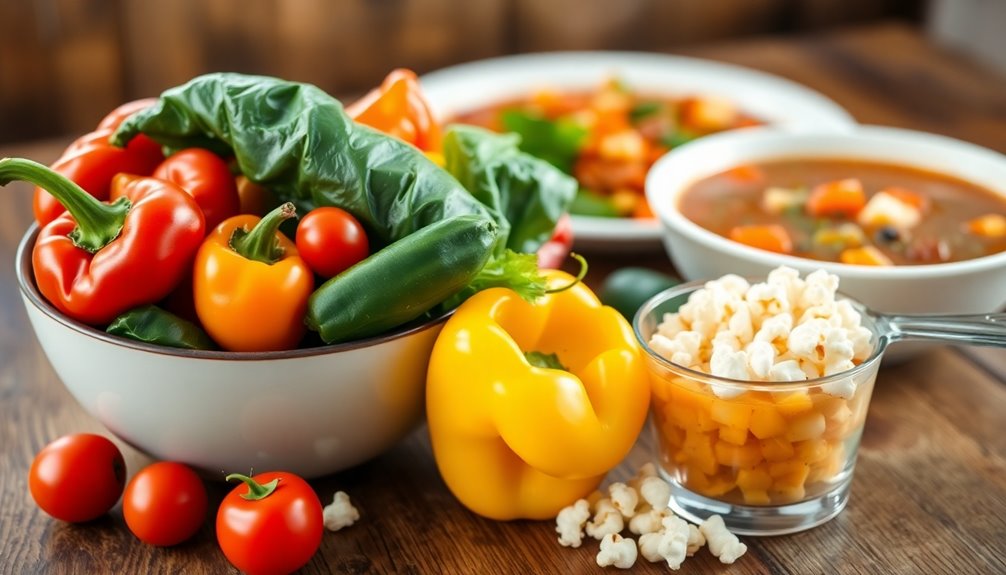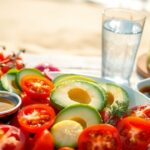The Volumetrics Diet is a practical eating plan designed to help you lose weight without feeling deprived. It focuses on low-energy density foods, like fruits, vegetables, and whole grains, allowing you to enjoy larger portions while reducing calorie intake. By listening to your body's satiety cues and embracing meal planning, you can manage hunger effectively. The diet encourages balanced nutrition with lean proteins and healthy fats while avoiding sugary and processed foods. With strategies like regular exercise and community support, it promotes long-term success. Discover more tips and insights to maximize your journey toward healthier eating habits.
Key Takeaways
- The Volumetrics Diet focuses on low-energy density foods like fruits and vegetables to promote weight loss while maintaining fullness.
- Meal planning and portion control are essential strategies to help manage hunger and ensure balanced nutrition.
- Incorporating lean proteins and healthy fats enhances the diet's effectiveness while avoiding sugary and processed foods.
- Regular physical activity and mindfulness practices are encouraged to support overall health and emotional well-being.
- Community support through online groups or fitness classes can motivate individuals to stay committed to their weight loss journey.
What Is the Volumetrics Diet?
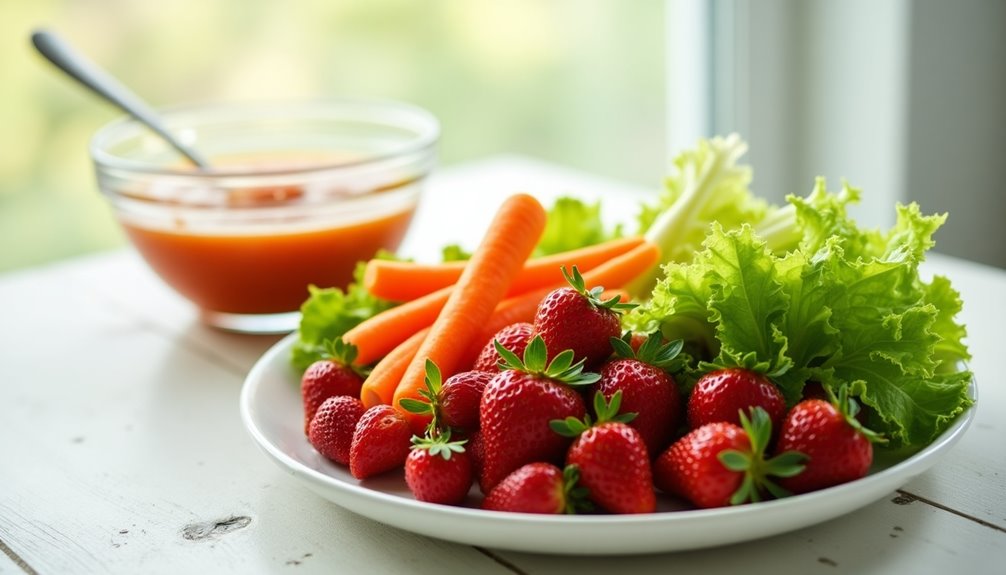
The Volumetrics Diet is a structured eating plan designed to help you manage your weight without feeling deprived. At its core, this diet emphasizes the importance of meal planning and portion control, allowing you to enjoy a wide variety of foods while still achieving your weight goals. By focusing on foods that are low in energy density—like fruits, vegetables, and whole grains—you'll find that you can eat larger portions without consuming excess calories.
One of the key aspects of the Volumetrics Diet is its approach to meal planning. You're encouraged to think strategically about what you eat, prioritizing foods that fill you up without weighing you down. This means incorporating high-volume, low-calorie options into your meals, which can help you feel satisfied and reduce the urge to snack unnecessarily.
Additionally, portion control plays an essential role in the success of this diet. You'll learn to recognize appropriate serving sizes, making it easier to enjoy your favorite foods in moderation. With practice, you'll become more adept at balancing your meals, ensuring you're nourished without going overboard on calories.
Ultimately, the Volumetrics Diet promotes a sense of belonging by fostering a supportive environment where you can share your progress and experiences with others. Engaging with a community can provide motivation and accountability, making your journey toward healthier eating enjoyable and sustainable. Embrace the power of meal planning and portion control, and you'll find a path that feels both fulfilling and manageable. Additionally, utilizing progress tracking tools can further enhance your weight management efforts and keep you accountable on your journey.
Key Principles of the Diet
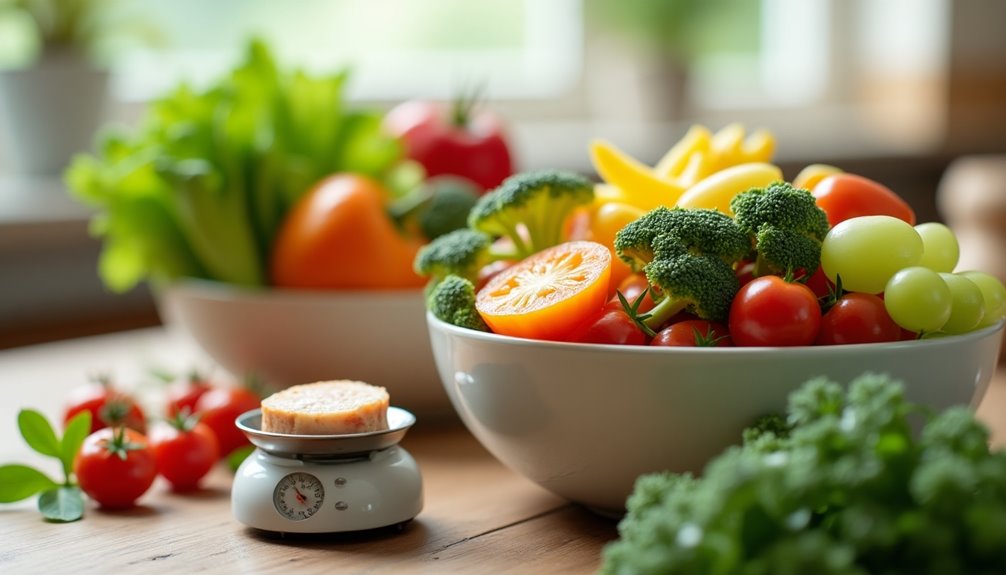
Understanding the key principles of the Volumetrics Diet can empower you to make healthier choices while still enjoying your meals. This approach focuses on eating foods that are low in calories but high in volume, allowing you to feel full without overeating. By practicing portion control, you can achieve weight loss while still satisfying your hunger levels.
Here are some essential principles to keep in mind:
- Choose low-calorie density foods: Incorporate fruits, vegetables, and whole grains into your meals. These foods not only fill you up but also provide essential nutrients.
- Listen to your satiety cues: Pay attention to your body's signals. Eat slowly and stop when you feel satisfied, rather than waiting until you're overly full.
- Plan your meals: Preparing meals in advance can help you maintain portion control and avoid impulsive eating.
- Stay hydrated: Sometimes thirst can be mistaken for hunger. Drink water throughout the day to help manage your appetite.
Additionally, maintaining a healthy liver is crucial as it plays a significant role in regulating blood sugar levels and filtering toxins from the body.
Benefits of the Volumetrics Diet

Adopting the Volumetrics Diet comes with a variety of benefits that can positively impact your overall health and well-being. One of the primary advantages is effective weight loss. By focusing on low-calorie-density foods, you can eat larger portions while consuming fewer calories. This approach not only helps you shed pounds but also makes your meals more satisfying, which can be vital for maintaining motivation on your weight loss journey.
Another significant benefit is hunger control. The Volumetrics Diet encourages you to fill up on foods rich in water and fiber, such as fruits, vegetables, and soups. These foods help you feel full longer, reducing the likelihood of snacking on high-calorie items. When you control hunger effectively, it becomes easier to stick to your dietary goals and avoid the frustration of constant cravings.
Furthermore, this diet promotes a balanced intake of nutrients, which can lead to enhanced energy levels and improved overall health. By emphasizing whole foods and portion control, you're not just focusing on losing weight; you're also fostering healthier eating habits that can last a lifetime. Implementing strategies that align with natural calorie cycles can further enhance the effectiveness of your weight loss efforts.
In a world where many diets can feel restrictive or unsustainable, the Volumetrics Diet stands out by allowing you to enjoy a variety of foods while prioritizing your health. By adopting this approach, you'll gain the tools to manage your weight and control hunger, all while feeling connected to a community that values wellness and balance.
Foods to Include and Avoid
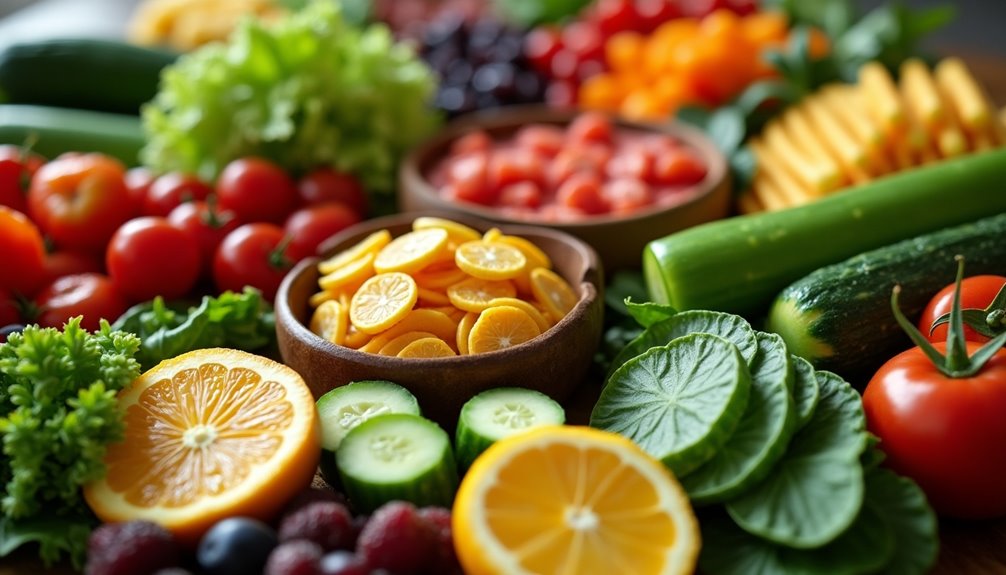
When following the Volumetrics Diet, incorporating a variety of nutrient-dense foods is key to achieving your health goals. This approach emphasizes portion control while ensuring you're getting the vitamins and minerals your body needs. By focusing on foods that provide high nutrient density, you can enjoy larger portions without compromising your dietary objectives.
To optimize your meals, consider including the following foods:
- Fruits and vegetables: These are low in calories and high in fiber, helping you feel full.
- Whole grains: Foods like brown rice, quinoa, and oats are excellent for providing energy and nutrients.
- Lean proteins: Incorporate sources like chicken, fish, beans, and legumes, which are filling and help maintain muscle mass.
- Healthy fats: Avocados, nuts, and olive oil offer essential fatty acids while still allowing for portion control.
On the flip side, try to avoid foods that are high in calories but low in nutrients, as they can undermine your efforts. Steer clear of:
- Sugary snacks and beverages: These often lead to cravings and don't fill you up.
- Processed foods: Many contain unhealthy fats and additives that don't support your health.
- High-calorie fast foods: They typically lack essential nutrients and can lead to overeating.
- Refined carbohydrates: Items like white bread and pastries may spike your blood sugar without providing lasting energy.
Additionally, a plant-based diet can be beneficial for achieving significant health benefits while still focusing on nutrient-dense foods.
Tips for Success on the Diet
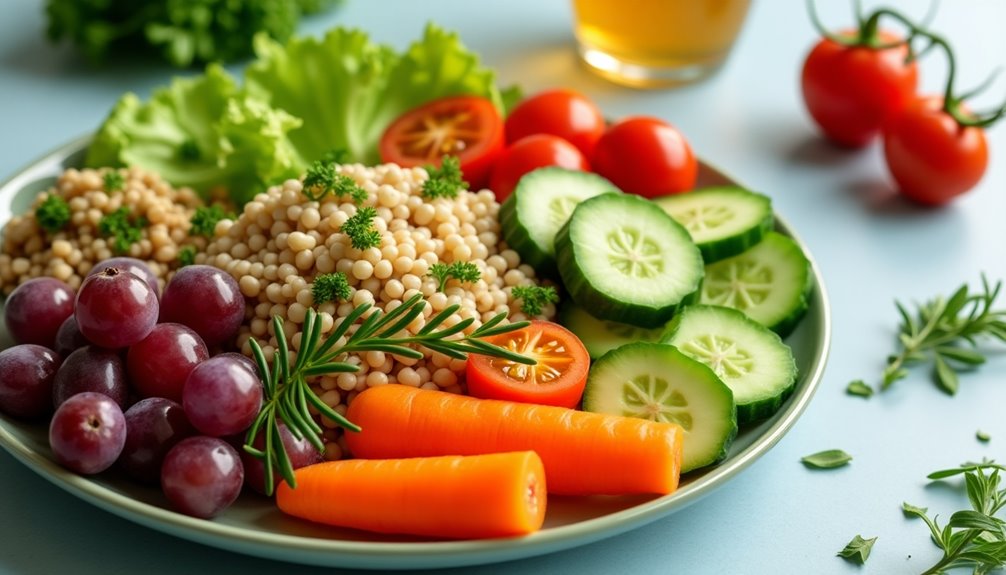
Success on the Volumetrics Diet depends on a few practical strategies that can enhance your experience and outcomes. One of the key elements is effective meal planning. By taking the time to organize your meals ahead of time, you can guarantee that you're incorporating a variety of low-energy-density foods, like fruits and vegetables, that will keep you full without piling on the calories. Planning your meals not only makes grocery shopping easier but also helps you avoid impulsive food choices that can hinder your progress.
Another vital factor is mastering portion control. Understanding how to serve appropriate portions can greatly impact your success. Use smaller plates and bowls to create an illusion of a fuller plate, which can help you feel satisfied with less food. Additionally, pay attention to hunger cues—eat when you're hungry and stop when you're satisfied. This approach will help you develop a more intuitive relationship with food.
Don't overlook the importance of staying hydrated. Sometimes, our bodies confuse thirst with hunger. Drinking water or herbal teas can help you feel fuller and curb unnecessary snacking.
Lastly, connect with others who are following the Volumetrics Diet. Sharing recipes, tips, and experiences can foster a sense of community and support, making your journey more enjoyable. Incorporating regular exercise, especially mind/body techniques, can also contribute to overall health and assist in managing weight effectively. Remember, it's not just about losing weight; it's about creating sustainable, healthy habits that fit your lifestyle. By incorporating these strategies, you'll be well on your way to achieving your goals with the Volumetrics Diet.
Frequently Asked Questions
Can I Follow the Volumetrics Diet While Pregnant?
Absolutely, you can focus on healthy weight management during pregnancy while ensuring you're meeting your nutrition needs. It's vital to prioritize pregnancy nutrition, emphasizing whole foods that support both you and your baby. Incorporating principles of portion control and nutrient density can help you maintain a balanced diet.
Just make sure to consult with your healthcare provider to tailor your approach, ensuring you're getting the right nutrients for a healthy pregnancy.
How Does the Volumetrics Diet Compare to Other Diets?
When comparing diets, focus on nutrient density and satiety levels. Many diets prioritize calorie restrictions, but those with high nutrient density, like the volumetrics approach, help you feel full while consuming fewer calories. This can lead to sustainable weight management.
Other diets may not emphasize the balance of nutrients, which can leave you feeling hungry. Choosing a diet that enhances satiety levels can make a significant difference in your overall experience and success.
Are There Any Risks Associated With the Volumetrics Diet?
When considering any diet, it's essential to weigh potential drawbacks and health concerns. You might experience initial hunger or fatigue as your body adjusts to new eating patterns. Some people may struggle with a lack of variety, leading to boredom with meals. Additionally, if you have specific health conditions, consulting a healthcare professional is pivotal. Overall, being aware of these factors can help you make informed decisions about your dietary choices.
Can I Combine the Volumetrics Diet With Exercise Programs?
Can you imagine a healthier, more active you? Absolutely! Combining a balanced diet with exercise programs is a winning strategy. Exercise benefits your physical and mental health, enhancing your energy and mood.
Plus, when you pair this with a sustainable eating approach, you're setting yourself up for long-term success. You'll not only feel great, but you'll also build a supportive community around your wellness journey.
How Long Does It Take to See Results on This Diet?
When you start a new diet, the timeline for seeing weight loss results can vary. Generally, you might notice changes within a few weeks, but sustainable results often take longer.
Health benefits like improved energy and mood may appear sooner. Remember, focusing on long-term lifestyle changes rather than quick fixes enhances sustainability.
Consistency and patience are key, so celebrate small victories along the way to keep you motivated and engaged in your journey.
Conclusion
To sum up, the Volumetrics Diet offers a practical approach to weight management by focusing on the nutritional density of foods. By selecting low-calorie, high-volume options, you can feel satisfied while still shedding pounds. But don't just stop here—consider the advantages of integrating these principles into your daily routine. Will you embrace this lifestyle change? With the right mindset and commitment, you might just discover a healthier, happier version of yourself. The choice is yours.

